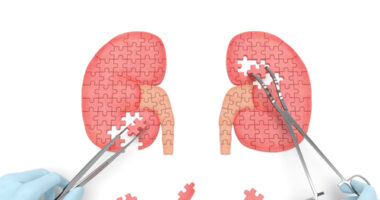Rare Genetic Mutation Leads to Severe X-linked Alport Syndrome in 10-year-old Boy, Case Study Finds

A rare type of mutation in the COL4A5 gene in a young boy led to severe X-linked Alport syndrome, according to a case report.
The report, “Somatic Mosaicism in a Male Patient With X-linked Alport Syndrome,” was published in the journal Kidney International Reports.
Alport syndrome is caused by mutations in three genes — COL4A3, COL4A4, and COL4A5 — which lead to defects in the collagen IV protein, the major constituent of a part of the kidney called the mature mammalian glomerular basement membrane.
Mutations in the COL4A5 gene, which is located in the X chromosome, give rise to X-linked Alport Syndrome, the most common type of the disease. Because females have two X chromosomes, the disease phenotype (set of symptoms) tends to be milder, while males with their one X chromosome have a 100% risk of developing end-stage kidney disease.
However, a rare type of X-linked mutation, called somatic mosaic mutation, has been linked with milder disease. In this type of genetic alteration, some individual cells acquire the mutation, while other cells keep a normal gene, giving rise to two genetically distinct populations of cells.
In this report, the team describes the case of a 10-year-old boy who showed increased levels of protein and blood in his urine.
Clinical examination found no problems with the boy’s hearing and vision but he had a duplex right kidney. A child with a duplex kidney (also called a duplicated collecting system) has two ureters — the tubes that carry urine from the kidney to the urinary bladder — coming from a kidney.
No other anatomic alterations were seen in the boy, and a left kidney biopsy confirmed the diagnosis of Alport syndrome. Microscopy analysis showed alterations of the kidney’s small blood walls, tubular shrinkage (atrophy), and scarring (fibrosis).
Genetic analysis of peripheral blood cells showed that the boy carried a mutation on a coding region of the COL4A5 gene. However, the mutational burden was 80% while the other 20% showed a normal gene. These results confirmed that this was a case of somatic mosaicism.
The researchers expected a more milder disease based on other reported cases of somatic mosaic X-linked Alport syndrome. However, “unlike previous cases, the 10-year-old boy we present here has a severe phenotype,” they wrote.
The researchers believe that the balance of mutated and normal cells, or the mutation tissue distribution, could explain the range of Alport severity in patients with this genetic alteration.







Leave a comment
Fill in the required fields to post. Your email address will not be published.